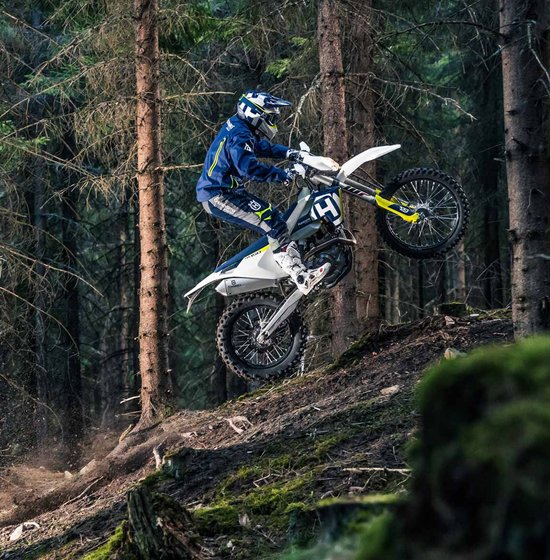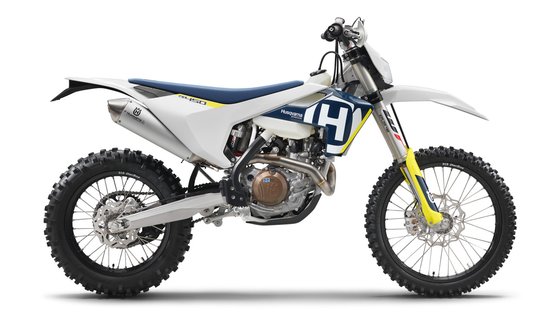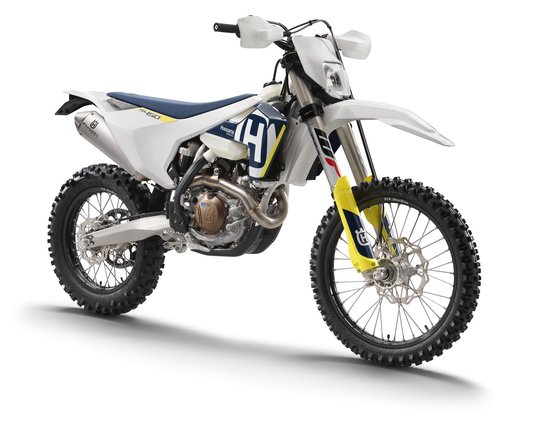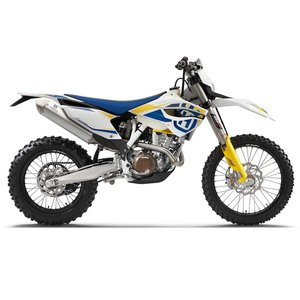Husqvarna FE 450 [2019-2020] Review: A Precision Tool for Enduro Dominance

Introduction
The Husqvarna FE 450 has long been a cornerstone of the enduro world, blending Swedish engineering with Austrian performance DNA. For the 2019-2020 model years, this machine refined its formula to near-perfection, offering a razor-sharp balance of power, agility, and technological sophistication. As a bike designed to conquer everything from rocky mountain passes to sandy riverbeds, the FE 450 doesn’t just ride terrain – it dissects it with surgical precision. After spending days thrashing this machine through mixed terrain, it’s clear why Husqvarna’s white-and-yellow warriors remain top contenders in the hardcore enduro scene.
Engine Performance: Controllable Fury

At the heart of the FE 450 lies a 449.9 cc single-cylinder four-stroke that’s as intelligent as it is intimidating. The 95 mm bore and 63.4 mm stroke create an engine character that’s more about usable torque than peak horsepower figures (which Husqvarna mysteriously never publishes). What matters here is how the power arrives: a tsunami of low-end grunt that builds linearly rather than explosively.
The Keihin EFI system deserves applause for its crisp throttle response. There’s none of the hesitation or bogging that plagued early fuel-injected enduro bikes. Whether you’re crawling over fallen logs at 2,000 RPM or screaming across open fields near redline, the fueling remains faultless.
Key technical highlights amplify the experience: - DDS Clutch: The Magura hydraulic-actuated DDS clutch is so light, you’ll think it’s connected by Bluetooth. Yet it bites decisively when you need to modulate power on slick roots. - Counter Balancer Shaft: Vibrations are remarkably subdued for a big single. You could ride this bike for hours without the usual hand numbness. - Gear-Driven Engine Maps: The 6-speed transmission isn’t just smooth – it’s psychic. The gear sensor tailors torque delivery in each cog, preventing unexpected wheelies when you short-shift.
Chassis & Handling: Ballet Dancer in a Bulletproof Vest

Husqvarna’s 25CrMo4 steel frame and carbon fiber subframe create a chassis that’s both forgiving and communicative. At 110.4 kg (243 lbs) dry, it flicks between trees with the agility of a 250cc machine, yet feels planted at speed. The secret lies in mass centralization – every component from the under-slung exhaust to the rearward tilted engine works to lower the center of gravity.
The WP Xplor 48mm forks and WP Monoshock offer 300mm (11.8") and 330mm (13") of travel respectively. Out of the box, the suspension is calibrated for technical enduro rather than desert racing. In slow, jagged terrain, the front end absorbs square-edged hits like a sponge, while the rear linkage maintains traction even when climbing near-vertical ledges.
Steering geometry plays its part: - 63.5° head angle: Sharp enough for quick direction changes, stable at speed - 107mm (4.2") trail: Resists deflection from rocks and ruts - 970mm (38.2") seat height: Manageable for most riders, though shorter pilots might yearn for a lowering kit
Electronics & Rider Aids: Silicon-Coached Aggression

For 2019-2020, Husqvarna doubled down on electronic rider aids without diluting the raw enduro experience: - Traction Control: Unlike street-biased systems, this isn’t a nanny. It subtly reduces torque spikes when the rear breaks traction, letting you charge harder through loose surfaces. - Map Switch: Two engine modes – Standard (linear) and Advanced (aggressive). The difference isn’t night and day, but Advanced mode sharpens throttle response for hill climbs. - Gear Position Sensor: Automatically softens power delivery in first and second gears for technical sections, then unleashes full fury in higher gears.
Competition: How It Stacks Against the Rivals
KTM 450 EXC-F
The FE 450’s orange cousin shares its engine and frame DNA but differs in suspension tuning. KTM’s WP XPLOR forks are slightly stiffer, favoring faster riders. However, Husqvarna’s carbon subframe and bodywork give it a edge in vibration damping.
Beta 430 RR-S
Beta’s 430cc challenger is 5kg lighter and feels more playful in tight woods. But the FE 450 counters with superior suspension action and a broader powerband. Beta riders often upgrade suspensions; Husqvarna owners rarely need to.
Yamaha WR450F
The Yamaha is bulletproof but dated. Its 5-speed gearbox and heavier chassis can’t match the Husky’s versatility. However, Yamaha’s 7.9L fuel tank beats Husqvarna’s 8.5L (2.3 gal) capacity for marathon races.
Maintenance: Keeping the Beast Hungry
The FE 450 isn’t a “wash and ride” machine – it demands respect in the workshop: - Oil Changes: Every 15 hours with Motorex Cross Power 4T 10W-50. The dual oil pumps are reliable but hate contaminated fluid. - Air Filter: Clean every ride. The twin-air foam filter is superb but consider a pre-filter for dusty conditions. - Valve Checks: 135-hour intervals. Shim-under-bucket design stays in spec longer than rivals. - Critical Upgrades: - Sprockets: Swap the stock 14/52 sprockets for 13/52 gearing (€85) for tighter trails. - Brake Pads: Magura pads last well, but sintered copper pads (€45) improve bite in mud. - Suspension Tuning: For riders over 85kg (187 lbs), a WP spring kit (€220) maintains sag settings.
Conclusion: The Enduro Specialist’s Swiss Army Knife
The 2019-2020 Husqvarna FE 450 isn’t just another dirt bike – it’s a masterclass in focused enduro engineering. From its vibration-free cockpit to the telepathic suspension, every component conspires to make you ride harder, longer, and with more confidence. While it demands diligent maintenance, the rewards are a machine that feels less like a motorcycle and more like an extension of your central nervous system.
At MOTOPARTS.store, we’ve got everything to keep your FE 450 in peak condition – from WP suspension rebuild kits to DDS clutch upgrades. Because when you’re this close to perfection, even small tweaks can unlock new dimensions of performance.
Specifications sheet
| Engine | |
|---|---|
| Stroke: | Four-stroke |
| Ignition: | Keihin EMS |
| Fuel system: | Keihin EFI |
| Lubrication: | Forced oil lubrication with 2 Eaton pumps |
| Displacement: | 449 ccm |
| Bore x Stroke: | 95 x 63.4 mm (3.7 x 2.5 in) |
| Configuration: | Single |
| Cooling System: | Liquid cooling |
| Compression ratio: | 11.8:1 |
| Number of cylinders: | 1 |
| Features | |
|---|---|
| Clutch: | Magura hydraulic DDS (Dampened Diaphragm Steel) wet clutch |
| Wheels: | Wire spoked (21" front / 18" rear) |
| Subframe: | Carbon fiber composite |
| Electronics: | Traction control, handlebar map switch, gear sensor |
| Dimensions | |
|---|---|
| Wheelbase: | 1482 mm (58.3 in) |
| Dry weight: | 110 |
| Seat height: | 970 mm (38.2 in) |
| Overall length: | 2260 mm (89.0 in) |
| Ground clearance: | 370 mm (14.5 in) |
| Fuel tank capacity: | 8.5 L (2.3 US gal) |
| Drivetrain | |
|---|---|
| Final drive: | chain |
| Transmission: | 6-speed, claw shifted |
| Rear sprocket: | 52 |
| Front sprocket: | 14 |
| Primary drive ratio: | 24:73 |
| Secondary drive ratio: | 14:52 (13:52 optional) |
| Maintenance | |
|---|---|
| Rear tire: | 140/90-18 |
| Chain type: | X-Ring 5/8 x 1/4 in |
| Engine oil: | 10W40 |
| Front tire: | 90/90-21 |
| Brake fluid: | DOT 4 |
| Spark plugs: | NGK CR8EIX |
| Coolant capacity: | 1.0 |
| Engine oil capacity: | 1.3 |
| Engine oil change interval: | Every 135 hours or 2 years, whichever comes first |
| Valve clearance (intake, cold): | 0.10–0.20 mm |
| Valve clearance check interval: | 24,000 km (15,000 mi) |
| Valve clearance (exhaust, cold): | 0.20–0.30 mm |
| Chassis and Suspension | |
|---|---|
| Frame: | 25CrMo4 steel central-tube frame |
| Trail: | 107 mm (4.2 in) |
| Rear brakes: | Single 220 mm disc, Magura 1-piston caliper |
| Front brakes: | Single 260 mm disc, Magura 2-piston caliper |
| Rear suspension: | WP Monoshock with linkage, adjustable spring preload and rebound damping |
| Front suspension: | 48mm WP-USD Xplor fork, preload adjustable |
| Rear wheel travel: | 330 mm (13.0 in) |
| Front wheel travel: | 300 mm (11.8 in) |
| Steering head angle: | 63.5° |



















